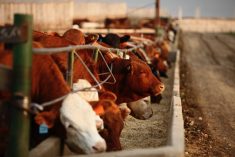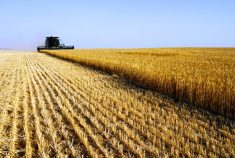Alberta packers bought fed cattle in the range of $120 to $121.50 per hundredweight (cwt) last week, up about $4/cwt from seven days earlier. Strength in fed cattle values, along and improvement in feeding margins, lifted the feeder market by $1-$3/cwt across Western Canada.
Cash barley continues to trade at $180 per tonne delivered in southern Alberta, as feed grain supplies remain burdensome. Pen closeouts are now showing some profitable margins, which have renewed buying enthusiasm for feeder cattle.
The U.S government shutdown temporarily lowered consumer confidence and spending but it now looks like this pent-up demand has stepped forward more aggressively. Wholesale beef values have improved and there is a strong seasonal trend for consumers to eat more during the fourth quarter. Stronger beef demand, along with a year-over-year decline in fourth quarter beef production, should bode well for feeder cattle prices over the next couple of months.
Read Also

U.S. grains: CBOT soybeans, corn, wheat fall in USDA data aftermath
Chicago grains took a dive on Friday, following a closely watched U.S. government crop report and the release of export data that could provide clues into Chinese buying.
A small group of exotic steers averaging 575 pounds sold for $167/cwt in southern Alberta. Charolais-cross steers weighing 625 lbs. traded at $159/cwt in the same region. In central Alberta, Simmental larger-frame steers averaging 700 lbs. were quoted at $162/cwt, so there appeared to be premiums for heavier replacements with little flesh.
Canadian feeder cattle exports to the U.S. for the week ending Oct. 14 were 8,933 head. Feeder cattle exports to the U.S. are up a whopping 81 per cent over last year and this trend will continue, given the premium of U.S. market over Canadian prices.
The monthly average price for 500- to 600-lb. steers for October will likely come in at $167/cwt, which is down from the record high of $183/cwt reached during February of 2012. The fed market will have to trade higher in order to justify further upside in the feeder market.
The cattle complex is now in a period when feedlots should have an opportunity to rebuild some equity. Cow-calf producers may be prudent to put their calves in a custom finishing lot, given the projected margin structure. The risk versus reward is more favourable than last year, given lower barley prices.
— Jerry Klassen is a commodity market analyst in Winnipeg and maintains an interest in the family feedlot in southern Alberta. He writes an in-depth biweekly commentary, Canadian Feedlot and Cattle Market Analysis, for feedlot operators in Canada. He can be reached by email at [email protected] for questions or comments.













